Abstract
The effects of strong earthquakes in the past years show that the acceleration of near fault earthquake, for having impact motion with long periods at the beginning of the record, “exerted” have significant differences with far-fault earthquakes. Adverse effects of such earthquakes increases by approaching the main time of period of structures to period of these earthquakes. Nowadays using energy dissipation systems, in order to reduce the vibrations of the structure has been very common. Such these energy dissipation systems can be noted viscose dampers that by having hysteresis loops of fat greatly increase energy loss in buildings. In this study, the number of dual-steel frames equipped with nonlinear viscous dampers and by applying records seismic near and far fault to the frames of 4, 6, 8 and 10 floors, behavior and response of these types of frames by nonlinear analysis and in Perform 3D software is evaluated.
1. Introduction
But after the destructive and strong earthquake Northridge 1994, Kobe 1995 or Chi Chi 1999 attention of researchers attracted to the near region earthquake and their characteristics [1]. Earthquakes of near region have higher acceleration and more limited frequency content in higher frequency values than far region earthquakes. Mapping of these earthquakes, especially when are under progressive direction taking, have long period pulses with strong slopes which are mostly at the beginning of the earthquake record [2]. In Fourier spectrum mapping earthquakes in near region rather than in spectral domain in a large range periodic have maximum value within a small region or in the other words in a particular period have maximum value. Existence of such behavior in near region earthquakes, causes behavior of the structure from the mode status which in it one or several of structure are determinative of structure behavior outed and have had that in case wave behavior caused by sum of effects of radiations passing through the structures [3]. These reason as wave motion is a reason on the impact of movements in the near region on long structures behavior. Incidence of pulse in the first record represents release of a significant kinetic energy in a short time, which is caused by the failure of the fault. [4]
In recent years scientists and engineers have come to the conclusion that the traditional approach to designing buildings based on stiffness and resistance, is replaced by the a new approach that absorb and dissipate energy plays an important role in it. [5]. the use of energy absorbing system after the first earthquake (1989) Loma Prieta was raised. In 1997 Dargoosh and colleagues provided a history of the energy absorbing systems [6]. In 1998, Constantine and Song presented the how to the design elements used in these systems to cope with lateral forces caused by the earthquake [7]. Structure Engineers Association of Northern California (SEAOC) in 1992 released guidelines based on using method of nonlinear in structures equipped with energy-absorbing systems [8]. In 1994, the Association SEAOC proposed a report on the application of energy absorbing systems in new buildings [9]. As well as other guidelines for evaluating buildings energy absorbing system can be noted 273 FEMA, 356 FEMA and 19 ATC [10, 11]. Similarly, in 2000 and 2003, NEHRP released Privacy Policy designing of systems with damper on the analysis of these systems based on linear methods and as equivalent lateral force [12]. In recent years, America Society of Civil Engineers guidelines for seismic loading conditions, analysis, and design of structures with damper) 05-7 (ASCE presented. [13]. more of these guidelines allow that design loads due to use of energy absorbing systems are reduced [14].
2. Analytical model specifications
In this article, 4 steel frame model, two-dimensional, four, six, eight and ten floors with the number of openings equal to five, with a width of four meters and a height of 3.2 meters using tenth topic of National Construction (Design and Construction steel buildings) and 2800 standard of Iran was designed [15, 16]. For example, for 4 and 6-storey building with 0.457 and 0.624, we have:
Similarly, for frames 8 and 10 floors allowed the relative displacement of 0.00476 is obtained. It is worth noting that this values to the equivalent of 0.7R are increased in nonlinear analysis and in order for frames 4 and 6 floors of 0.025 and for 8 and 10 floors frames is 0.02. Models after the design in ETABS and determining the controls necessary sections and again in the application of nonlinear analysis PERFORM 3D, has modelled. Due to passing from the linear region and the need to define the properties and performance of materials in the region of nonlinear members, the criteria have been used to improve guidelines [17]. In Table 1 also period obtained from linear and nonlinear static analysis has been presented.
Table 1Periodicity of models
Models | Periodicity (s) | |
ETABS | PERFORM | |
4 floors | 0.457 | 0.442 |
6 floors | 0.624 | 0.611 |
8 floors | 1.114 | 1.081 |
10 floors | 1.182 | 1.168 |
2.1. Accelerogram earthquake near and far faults
In order to achieve the desired goals, fourteen registered record was used that seven records of earthquakes near field and seven other records is related to the far field. All records studied in soil of type 2 (according to the 2800 standard classification of Iran) have been chosen, that this acceleration mapping along with their characteristics are presented in Tables 2 and 3.
Table 2Mapping earthquake of far field with a distance of 70 to 100 km
Row | Location of occurrence | Year | Station | Distance | Intensity | PGA (g) |
1 | Kern County | 1952 | Taft | 81 | 7.4 | 0.17 |
2 | Tabas | 1978 | Dayhook | 107 | 7.4 | 0.4 |
3 | Imperial valley | 1979 | Calexico | 90.6 | 6.5 | 0.27 |
4 | Loma Prieta | 1989 | Presidio | 83.1 | 6.9 | 0.099 |
5 | Loma Prieta | 1989 | Cliff House | 84.4 | 6.9 | 0.107 |
6 | Manjil | 1990 | Abbar | 74 | 7.3 | 0.51 |
7 | Kocaeli | 1999 | Ambarli | 78.9 | 7.4 | 0.18 |
Table 3earthquake records near filed to distance of 10 km
Row | Location of occurrence | Year | Station | Distance | Intensity | PGA (g) |
1 | Kocaeli | 1999 | Sakarya (90) | 3.1 | 7.6 | 0.37 |
2 | Chi-Chi, | 1999 | Tcu052 N | 0.24 | 7.6 | 0.41 |
3 | Chi-Chi, | 1999 | Tcu052 W | 0.24 | 7.6 | 0.34 |
4 | Chi-Chi, | 1999 | TCU068 (N) | 1.09 | 7.6 | 0.46 |
5 | Chi-Chi | 1999 | TCU068 (W) | 1.09 | 7.6 | 0.56 |
6 | Chi-Chi, | 1999 | TCU072 (W) | 1.79 | 7.6 | 0.3 |
7 | Chi-Chi | 1999 | TCU128 (W) | 9.7 | 7.6 | 0.139 |
Fig. 1Maximum displacement of frame of 10,8,6 and 4 floors (near and far fault)
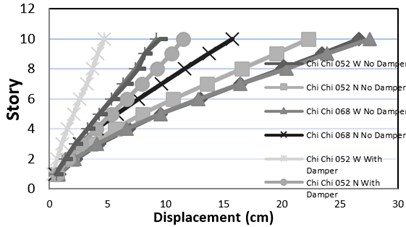
a) 10 story near fault
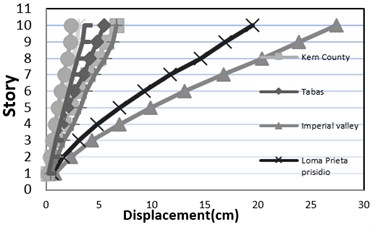
b) 10 story far fault
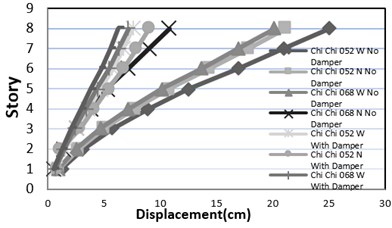
c) 8 story near fault
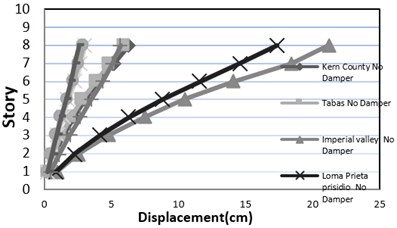
d) 8 story far fault
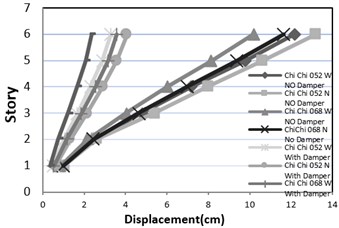
e) 6 story near fault
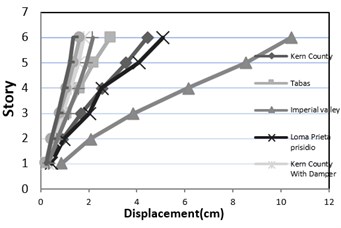
f) 6 story far fault
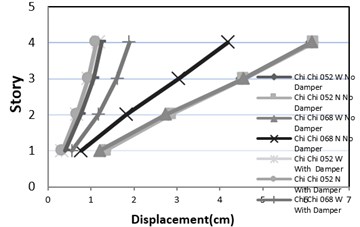
g) 4 story near fault
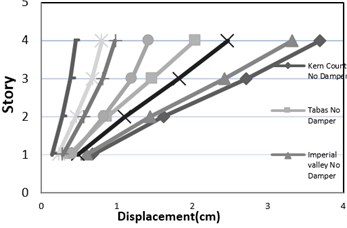
h) 4 story far fault
3. Graphs of relative displacement classes and maximum displacement of classes
The results overall and relative displacement of classes for all frames 4, 6, 8 and 10 floors in conditions fault for both near and far without viscous damper and with viscous damper linear has been calculated for the number of records. Diagrams related to displacements of overall classes in Fig. 1 have been presented.
As can be seen in more of charts the overall displacement caused by the near field records in compared with the records of far area have huge difference that this difference in continue in the diagrams related to relative displacement classes can be seen, it would need to consider the effects of near area records of fault. As expected, values related to overall and relative displacement classes in the near field than values of the far area were higher after using viscous dampers in models values related to overall and relative displacement classes both in the records of near field and far field records decreased significantly. This reduction in values of total and relative displacement due to existence of impact pulses in near field earthquake records classes in greater value was performed. This indicates that the accuracy of previous studies on the use of dampers has power of 0.5 on the power-speed related to the viscous damper. It is worth noting that the reduction made in values of total and relative displacement in those records of far field had pulse beats like, and most of the energy of the earthquake in a short timeframe transferred to structure, in compared with other far field records to the greater value was performed. This reflects the ability of damper used in absorbing severe powers damage to the structure in short time. By increasing the height necessity of using more energy absorbing devices will be displayed. For example, total and relative displacement of classes in model of 10 floors in the effect of near field earthquake Chi-Chi 068 W, in the case of viscous damper of values 56. 27 cm and 0.0119, respectively, in values of 2.9 cm and 0.00239 is decreased.
As seen in these figures, with the viscous damper installation in frames the frames behavior has been more predictable. In Figs. 2 and 3 the relative displacement of classes for the 10 floors frame in the near and far filed has been presented.
Fig. 2Relative displacement of 10 floors model under the near field record

Fig. 3Relative displacement of 10 floors model under far field record

3.1. Cutting base
Another benefit of using viscous dampers is reduction of the amount of cutting base and this has been clearly demonstrated in studies conducted by the researchers. Tables 4 and 5 includes the maximum values of cutting base in two modes without the presence of viscous damper and with viscous damper are for the near and far field earthquakes. As can be seen values for the base cutting in near field earthquakes is greater than the values for far field. It seems as if the same frame as the equivalent static analysis in that case should be considered for the near faults mode a higher cutting base. If the use of viscous damper in models, on average cutting base values by 30 percent in near field earthquakes and in far field earthquake was reduced by 50 percent. The maximum values of reduced cutting base in models in Tables 4 and 5 have been presented. As can be seen maximum value of cutting base that in table below has been shown that is relevant to near field earthquake of Chi-Chi TCU 052 W. Record of this earthquake at the beginning of itself has a movement of intense pulse like that more of its energy is applied to the structure as an impact and viscous damper used as well the impact entered have absorbed and dissipated, so that the value of cutting base from the value of 168.38 in the case without viscous damper to value of 66.72 in the mode of using viscous damper is reduced.
Table 4Comparison of cutting base in two modes of without and with additional damper near field fault
Near field earthquakes | 4 floors | 6 floors | 8 floors | 10 floors | ||||
Without damper | With damper | Without damper | With damper | Without damper | With damper | Without damper | With damper | |
Chi -Chi TCU 052 W | 27.04 | 5.84 | 65.18 | 20.99 | 151.64 | 51.81 | 168.38 | 66.72 |
Chi Chi TCU 052 N | 26.2 | 5.55 | 75.15 | 20.55 | 128.84 | 59.83 | 135.22 | 79.28 |
Chi Chi TCU 068 W | 25.51 | 9.57 | 54.77 | 23.33 | 122.34 | 48.61 | 169.56 | 69.38 |
Chi Chi TCU 068 N | 16.68 | 6.43 | 62.84 | 15.44 | 67.37 | 39.61 | 98.53 | 70.05 |
Chi Chi TCU 072 W | 18.64 | 9.37 | 67.37 | 39.62 | 35.47 | 28.89 | 54.04 | 36.68 |
Chi Chi TCU 0128 W | 5.94 | 2.53 | 35.47 | 28.89 | 25.04 | 8.89 | 43.35 | 22.75 |
Kocaeli Sakarya | 11.08 | 7.46 | 72.38 | 23.89 | 72.38 | 23.89 | 109.18 | 32.54 |
Table 5Comparison of cutting base in two modes of without and with additional damper far field fault
Far field earthquakes | 4 floors | 6 floors | 8 floors | 10 floors | ||||
Without damper | With damper | Without damper | With damper | Without damper | With damper | Without damper | With damper | |
Kern County | 14.73 | 3.94 | 23.69 | 11.29 | 39.46 | 21.58 | 47.47 | 24.356 |
Tabas | 8.74 | 7.48 | 17.34 | 10.68 | 36.54 | 19.88 | 40.84 | 20.3 |
Imperial Valley | 13.42 | 5.42 | 55.42 | 13.88 | 131.44 | 38.78 | 156.49 | 51.68 |
Loma Prieta (Prisidio) | 10.19 | 2.56 | 26.5 | 8.97 | 106.3 | 23.86 | 128.39 | 28.56 |
Loma Prieta (Cliff House) | 3.89 | 0.74 | 15.07 | 2.71 | 46.18 | 9.53 | 67.79 | 14.27 |
Manjil | 13.26 | 6.07 | 18.28 | 10.65 | 33.65 | 21.3 | 73.24 | 19.98 |
Kocaeli Ambrili | 10.34 | 2.05 | 43.38 | 10.6 | 111.27 | 22.56 | 129.3 | 40.67 |
4. Conclusions
1) The survey results show that given the special characteristics of near field fault of records show the different behavior of structures under the effect of records. Although numerical results obtained in this study perfectly depend on specifications frames designed and records and other factors such as structure conditions of site, however, in general can be concluded that structures under the effect of these records have different behavior. Need of displacement near fault records in comparison with the need for displacement of far fault records was found. The maximum relative displacement under near field records in frames of 4 and 6 floors occur in the elementary floors and in the frames of 8 and 10 floors occur in middle floors. The reason for this is that with the increase in models, the participation and influence of higher modes are more in structural response. So the high frequency content of the earthquakes near fault, the upper floors is more affected. 2) In most cases, the amount of cutting base obtained from linear and nonlinear dynamic analysis of time history for near fault records is more than far fault records If the design in static analysis method should be further considered by using the coefficients, cutting base for near fault that the Code UBC97 these factors in a table has been offered and its vacancies, in 2800 code of Iran is felt. 3) The increasing the height of frames and thus increase the number of added dampers, a greater reduction in the amount of relative displacement and cutting base was observed that this show efficiency of this type of dampers in high structures. 4) Due to, easy to install this type of damper in building frames and also due to having the most populous country in the near fault and the probability of occurrence of earthquake, viscous dampers can be used to retrofit existing buildings in these areas.
References
-
Dadgar Soroush The Effect of Viscous Dampers on the Seismic Behavior of a Double Frame Rate and Determine Their Behavior. Master’s Thesis, Razi University, 2013.
-
Housner G. W., Trifunak M. D. Analysis of accelerograms – parkfield earthquake. Bulletin of the Seismological Society of America, Vol. 57, 1967, p. 1193-1220.
-
Moehle J. P. Seismic analysis, design and review for tall building. The Structural Design of Tall and Special Buildings, Vol. 15, 2006, p. 495-513.
-
Kalkan E., Kunnath S. K. Effect of fling step and forward directivity on seismic response of buildings. Earthquake Spectra, Vol. 22, 2006, p. 367-390.
-
FEMA-440 (ATC-55), Improvement of Nonlinear Static Seismic Analysis Procedures. Applied Technology Council, Federal Emergency Management Agency, Washington DC, 2005.
-
Soong T. T., Dargoush G. F. Passive Energy Dissipation Systems in Structural Engineering. John Wiley and Sons Ltd., London, New York, 1997.
-
Constantinou M. C., Soong T. T., Dargush G. F. Passive Energy Dissipation Systems for Structural Design and Retrofit. Monograph Series No. 1, Multidisciplinary Center for Earthquake Engineering Research, University at Buffalo, State University of New York at Buffalo, Buffalo, NY, 1998.
-
Recommended Lateral Force Requirements and Commentary. SEACO – Structural Engineering Association of Northern California, California, 1992.
-
Recommended Lateral Force Requirement and Commentary. SEACO – Structural Engineering Association of Northern California, Sacramento, CA, 1999.
-
NEHRP Guidelines for the Seismic Rehabilitation of Buildings and NEHRP Commentary on the Guidelines for the Seismic Rehabilitation of Buildings. FEMA – Federal Emergency Management Agency, Reports No. FEMA-273 and FEMA-274, Washington, D.C., 1997.
-
Structural Response Modification Factors: ATC-19. ATC – Applied Technology Council, Redwood City, California, p. 5-32.
-
NEHRP Recommended Provisions for Seismic Regulations for New Buildings and Other Structures. NEHRP – National Earthquake Hazard Reduction Program, Federal Emergency Management Agency, Report No. FEMA 302, Washington D.C., 1997.
-
Minimum Design Loads for Buildings and Other Structures. ASCE7-05, American Society of Civil Engineering, Reston, Virginia, 2006.
-
NEHRP Recommended Provisions for Seismic Regulation for New Buildings and Other Structures. NEHRP – National Earthquake Hazard Reduction Program, Appendix to Chapter 13, Structures with Damping Systems, Federal Emergency Management Agency, Washington, DC, 2003.
-
Regulations Buildings Against Earthquake Load (Standard 84-2800 Iran). Third Edition, Building and Housing Research Center.
-
Office and Promote the Development of National Building Regulations. The 10th issue of National Construction (Design and Construction of Steel Buildings), 2008
-
Instructions Seismic Rehabilitation of Existing Buildings. Technical Publication No. 360, Office and the Formulation of Criteria, Management and Planning Organization, International Institute of Seismology and Earthquake Engineering, 2006.
